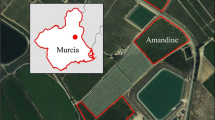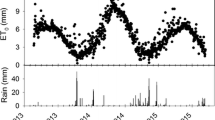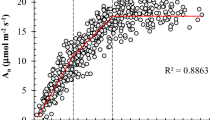Abstract
Irrigation of olive orchards is challenged to optimize both yields and oil quality. Best management practices for olive irrigation will likely depend on the ability to maintain mild to moderate levels of water stress during at least some parts of the growing season. We examined a number of soil, plant and remote sensing parameters for evaluating water stress in bearing olive (var. Barnea) trees in Israel. The trees were irrigated with five water application treatments (30, 50, 75, 100 and 125% of potential evapotranspiration) and the measurements of soil water content and potential, mid-day stem water potential, and stomatal resistance were taken. Remote thermal images of individual trees were used to alternatively measure average canopy temperature and to calculate the tree’s crop water stress index (CWSI), testing empirical and analytical approaches. A strong non-linear response showing similar trends and behavior was evident in soil and plant water status measurements as well as in the CWSI, with decreasing rates of change at the higher irrigation application levels. No statistically significant difference was found between the analytical and the empirical CWSI, suggesting that the relative simplicity of the analytical method would make it preferable in practical applications.






Similar content being viewed by others
References
Berenguer MJ, Vossen PM, Grattan SR, Connell JH, Polito VS (2006) Tree irrigation levels for optimum chemical and sensory properties of olive oil. HortScience 41:427–432
Campbell GS, Campbell MD (1982) Irrigation scheduling using soil moisture measurements: theory and practice. Adv Irrig 1:25–42
Charlesworth P (2005) Soil water monitoring. CSIRO/CRC irrigation futures. Land and Water Australia, Canaberra
Cohen Y, Alchanatis V, Meron M, Saranga Y, Tsipris J (2005) Estimation of leaf water potential by thermal imagery and spatial analysis. J Exp Bot 56(417):1843–1852
D’Andria R, Morelli G, Martuccio G, Fontanazza G, Patumi M (1996) Evaluation of yield and oil quality of young olive trees under different irrigation regimes. Italus Hortus 3:23–31
Dag A et al (2008) The effect of irrigation level and harvest mechanization on virgin olive oil quality in a traditional rain-fed “Souri” olive orchard converted to irrigation. J Sci Food Agric 88:1524–1528
Diaz-Espejo A, Nicolas E, Fernandez JE (2007) Seasonal evolution of diffusional limitations and photosynthetic capacity in olive under drought. Plant Cell Environ 30(8):922–933
Fuchs M (1990) Infrared measurement of canopy temperature and detection of plant water-stress. Theor Appl Climatol 42(4):253–261
Gómez-Rico A, Salvador MD, La Greca M, Fregapane G (2006) Phenolic and volatile compounds of extra virgin olive oil (Olea europaea L. Cv. Cornicabra) with regards to fruit ripening and irrigation management. J Agric Food Chem 54:7130–7136
Gómez-Rico A et al (2007) Influence of different irrigation strategies in a traditional Cornicabra cv. olive orchard on virgin olive oil composition and quality. Food Chem 100:568–578
Gontia NK, Tiwari KN (2008) Development of crop water stress index of wheat crop for scheduling irrigation using infrared thermometry. Agric Water Manage 95(10):1144–1152
Gucci R, Lombardini L, Tattini M (1997) Analysis of leaf water relations in two olive (Olea europaea) cultivars differing in tolerance to salinity. Tree Physiol 17:13–21
Guilioni L, Jones HG, Leinonen I, Lhomme JP (2008) On the relationships between stomatal resistance and leaf temperature in thermography. Agric For Meteorol 148:1908–1912
Irmak S, Haman DZ, Bastug R (2000) Determination of crop water stress index for irrigation timing and yield estimation of corn. Agron J 92(6):1221–1227
Jackson RD, Idso SB, Reginato RJ, Pinter JPJ (1981) Canopy temperature as a drought stress indicator. Water Resourc Res 17:1133–1138
Jackson RD, Kustas WP, Choudhury BJ (1988) A re-examination of the crop water stress index. Irrig Sci 9:309–317
Jones HC (1992) Plants and microclimate. Cambridge University Press, Cambridge
Jones HG (1999) Use of infrared thermometry for estimation of stomatal conductance as a possible aid to irrigation scheduling. Agric For Meteorol 95(3):139–149
Jones HG (2004) Irrigation scheduling: advantages and pitfalls of plant-based methods. J Exp Bot 55:2427–2436
Meron M, Tsipris J, Charitt D (2003) Remote mapping of crop water status to assess spatial variability of crop stress. In: Strafford J, Werner A (eds) Precision agriculture. Proceedings of the fourth European conference on precision agriculture. Academic Publishers, Berlin, pp 405–410
Möller M et al (2007) Use of thermal and visible imagery for estimating crop water status of irrigated grapevine. J Exp Bot 58(4):827–838
Monteith JL (1965) Evaporation and environment. Symp Soc Exp Biol XIX:205–234
Monteith JM, Unsworth MH (2008) Principles of environmental physics. Elsevier, New York
Moriana A, Villalobos FJ, Fereres E (2002) Stomatal and photosynthetic responses of olive (Olea europaea L.) leaves to water deficits. Plant Cell Environ 25(3):395–405
Moriana A, Orgaz F, Fereres E, Pastor M (2003) Yield responses of a mature olive orchard to a water deficits. J Am Soc Hortic Sci 128:425–431
Moriana A et al (2007) Irrigation scheduling for traditional, low-density olive orchards: water relations and influence on oil characteristics. Agric Water Manag 87:171–179
Naor A (2006) Irrigation scheduling and evaluation of tree water status in deciduous orchards. Hortic Rev 32:111–165
Patumi M et al (1999) Yield and oil quality of intensively trained trees of three cultivars of olive (Olea europaea L.) under different irrigation regimes. J Hortic Sci Biotechnol 74:729–737
Patumi M et al (2002) Olive and olive oil quality after intensive monocone olive growing (Olea europaea L., cv. Kalamata) in different irrigation regimes. Food Chem 77:27–34
Sela E et al (2007) Thermal imaging for estimating and mapping crop water stress in cotton. In: Stafford JV (ed) European conference in precision agriculture 2007. Wageningen Academic Publications, The Netherlands, pp 365–371
Sepulcre-Canto G et al (2006) Detection of water stress in an olive orchard with thermal remote sensing imagery. Agric For Meteorol 136(1–2):31–44
Sepulcre-Canto G et al (2007) Monitoring yield and fruit quality parameters in open-canopy tree crops under water stress. Implications for ASTER. Remote Sens Environ 107(3):455–470
Tovar MJ, Romero MP, Alegra S, Girona J, Motilva MJ (2002a) Composition and organoleptic characteristics of oil from Arbequina olive (Olea europaea L) trees under deficit irrigation. J Sci Food Agric 82:1755–1763
Tovar MJ, Romero MP, Girona J, Motilva MJ (2002b) l-Phenylalanine ammonia-lyase activity and concentration of phenolics in developing olive (Olea europaea L. cv Arbequina) fruit grown under different irrigation regimes. J Sci Food Agric 82:892–898
Acknowledgments
This work was supported by The Chief Scientist of Israel’s Ministry of Agriculture and Rural Development (award #304-0300), the Middle East Regional Irrigation Management Information System (MERIMIS/USDA-ARS), and the Netafim Company. Special thanks to TZABA”R KA”MA for technical and horticultural support and cooperation in establishing and maintaining the experimental orchard.
Author information
Authors and Affiliations
Corresponding author
Additional information
Communicated by S. Raine.
Rights and permissions
About this article
Cite this article
Ben-Gal, A., Agam, N., Alchanatis, V. et al. Evaluating water stress in irrigated olives: correlation of soil water status, tree water status, and thermal imagery. Irrig Sci 27, 367–376 (2009). https://doi.org/10.1007/s00271-009-0150-7
Received:
Accepted:
Published:
Issue Date:
DOI: https://doi.org/10.1007/s00271-009-0150-7




